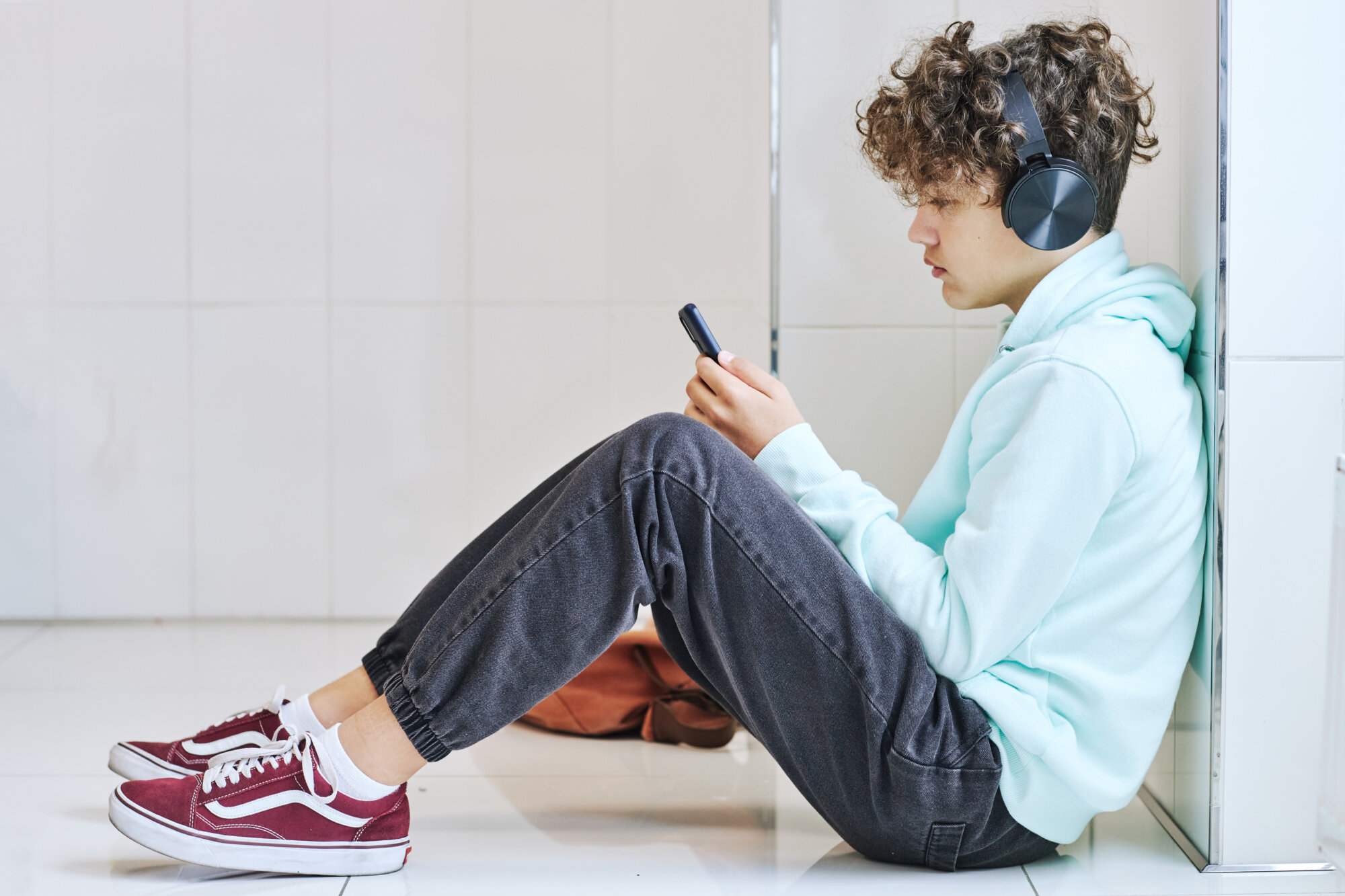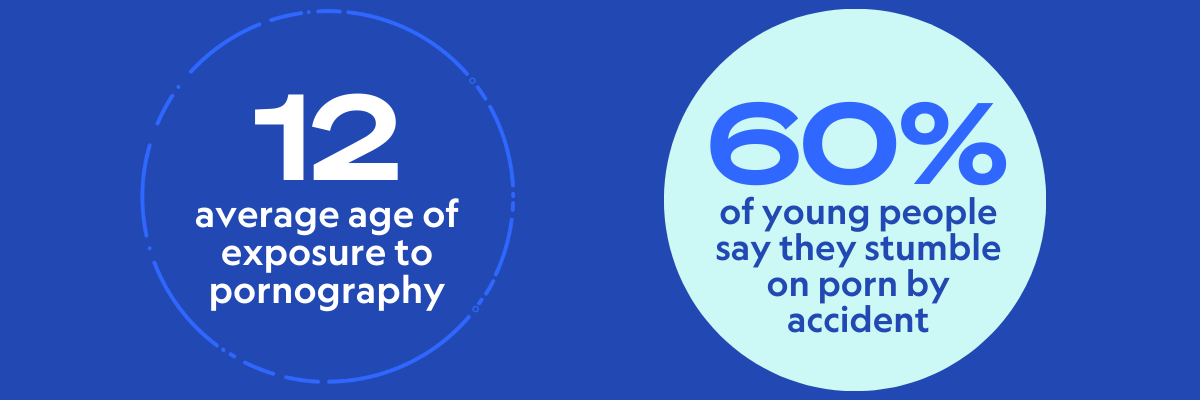
Porn and Mental Health
Understanding the Impact on Young People
As digital devices increasingly become a part of daily life for young people, especially tweens and teens, they also are more likely to encounter inappropriate content like porn. This growing reality raises new concerns related to the connection between porn and mental health that may have long-term effects on a youth’s well-being.
Those concerns are backed by research showing that exposure to pornography at a young age can significantly affect a child’s development and mental health. Growing amounts of research on mental health and porn use among adolescents document that it contributes to anxiety, depression, and overall well-being — now and in the future. Teens who view online porn are particularly susceptible to its emotional and cognitive effects, as they are in a crucial time for brain development.
Because the adolescent brain is forming new patterns of behavior, the effects of porn on the brain at this age are exacerbated. This includes greater vulnerability to mental health issues, including dysfunctional stress responses and poor executive function, including impairments in judgment, memory, and emotional regulation.
Research shows there are long-term implications related to how porn affects mental health. Adolescents who use porn also are more vulnerable to mental health issues including reduced ability to interact in social situations and increased likelihood of emotional, social, and sexual problems in adult life.
To explore the issues surrounding how porn affects the brain and mental health, Culture Reframed compiled highlights of research and information to help parents, caregivers, educators, and others better understand the issue and how to help young people stay safe online.
- How Porn Affects the Brain and Mental Health
- Porn and Anxiety: What the Research Shows
- Porn and Depression: Understanding the Link
- What Can Parents, Caregivers, and Young People Do?
- Resources and Further Reading
How Porn Affects the Brain and Mental Health
Research confirms that pornography use at a young age can significantly influence long-term brain development with implications for mental health. The effects of porn on the brain are especially relevant for adolescents, who are at a critical age as they are forming the foundations of neural pathways that contribute to long-term brain development. Because adolescent brains are highly vulnerable to forming new patterns of behavior — both positive and negative — porn exposure at this age can have a strong impact.

Surveys show that the average age of first exposure to pornography is 12 years old, and three-quarters of teens say they have viewed pornography by the age of 17. For tweens and teens, the effects of porn on the brain are amplified. Over time, the effects of porn on the brain can make teens more vulnerable to mental health issues including:
- depressive symptoms
- reduced ability to interact in social situations
- trouble bonding with emotional caregivers
- behavioral problems
- sexual aggression
- low self-esteem and poor body image
- increased likelihood of emotional, social, and sexual problems in adult life
For all viewers, pornography prompts the release of dopamine, a neurotransmitter that allows us to feel pleasure. When engaging with pornography, the brain encounters unnaturally high dopamine levels that can affect its reward circuitry and natural ability to produce dopamine.

Researchers also are starting to uncover evidence of another effect of porn on the brain: obsessive use of pornography as an addictive behavior. Some studies indicate that online porn may amplify the effects on brain receptors that are involved with addictive behavior. One study on the potential relationship between compulsive use of pornography and mental health in university students indicated a significant relationship between mental health and pornography use, including addictive behaviors.
If pornography becomes a compulsive or addictive behavior, it can change the brain in similar ways as drug addiction. MRI scans reveal similar changes in gray and white brain matter among people with drug addiction and those who have compulsive pornography use. These metabolic changes are likely to be exacerbated among young people exposed to porn.
In addition to the effects of porn on the adolescent brain, tweens and teens may encounter mental health issues related to unhealthy use of social media, gaming, and other digital platforms. Research has found that about one in 10 teens has problematic levels of social media or gaming use. Both of these can contribute to lower levels of mental and social well-being.
Porn and Anxiety: What the Research Shows
The connection between porn and anxiety also has been a focus of researchers. Recent studies have found a strong relationship between the use of porn and increased anxiety, stressful experiences, and depression. This is found among younger people, as shown in a survey focused on college males that found a link between more frequent use of online porn and anxiety, depression, stress, avoidance, and other social functioning.
Other research examines how porn and anxiety play a role in relationships, with one study finding an association between frequency of porn viewing and lower relationship and refusal skills. The hypersexual images in online porn have also been found to increase some forms of sexual insecurity and sexual expectations that affect personal relationships.
Research on people who self-identify as problematic users of online porn found they are likely to have symptoms of anxiety and depression, poor concentration, and an inability to focus on essential tasks. Their use of porn also meant they slept less and had poorer moods and less social engagement that made it difficult to have meaningful and connected personal relationships.
Learn more about how porn affects the brain and mental health:
Porn and Depression: Understanding the Link
Multiple studies have identified a connection between porn and depression. While pornography use sometimes begins as a distraction from depression or other negative emotions, studies find that pornography addiction can also lead to and exacerbate feelings of depression, isolation, loneliness, and anxiety.
People with depression often suffer from reduced serotonin levels; because serotonin is released during orgasm, people with depression can use this as a serotonin boost. Dopamine is another brain chemical relevant to porn and depression for several reasons:
- Dopamine is responsible for pleasure, satisfaction, and motivation.
- When dopamine is not functioning correctly, people can feel moody, tired, and unmotivated.
- Dopamine also plays a significant role in sleep patterns, motivation, learning ability, mood stability, and awareness.
People who experience difficulty with emotional regulation — the process of assessing and modifying emotional reactions — can be more prone to problematic pornography use. Studies show that people with emotion regulation difficulties can be more likely to experience addictive behaviors, including compulsive sexual behaviors. Depression is also a disorder of impaired emotional regulation, particularly in processing negative events.
Pornography use can be a way to stimulate pleasurable brain chemicals and distract from or repress negative emotions. However, as with drug addiction, over time people develop a tolerance to viewing porn, and require increased stimulation to achieve the same pleasurable response.
Pornography addiction is linked to anxiety, loneliness, shame, and guilt. As people increase pornography use in response to developing a tolerance to it, these feelings of anxiety, loneliness, and guilt can increase as well. This leads to further isolation, creating a negative cycle of excessive porn use and depressive symptoms.
What Can Parents, Caregivers, and Young People Do?
Having age-appropriate conversations with children, tweens, and teens and teaching them safe and responsible online behavior are key to proactively mitigating harms associated with porn and mental health. In addition to blocking objectionable material and frequently monitoring children’s and teens’ online and social media use, resources and recommendations for parents and educators can help children develop healthy self-esteem, body confidence, and safe, loving relationships.
These resources from Culture Reframed and other organizations can help parents and caregivers address concerns about porn and mental health in children:
- Parents of tweens and teens can sign up for free courses. Each self-paced course takes parents and caregivers through key topics and provides talking points for conversations to help young people navigate hypersexualized culture.
- This free porn-critical curriculum is designed for educators and other professionals who teach sex education to young people 13 and older. Free and customizable, the curriculum incorporates into sex education programs the harmful effects of widespread mainstream hardcore pornography and hypersexualized media.
- Parents need to be aware of what their kids see and hear online, who they are meeting, and what they are sharing about themselves. This free guide for parents provides guidelines for parental supervision and teaching safe and responsible online behavior.
- Online tools can help parents control their children’s access to certain online material and help protect them from online predators. Here are some ideas on how to monitor and protect a child’s devices. Parental control apps, including Canopy, are another option. Remember that tools to protect kids online are helpful, but not as important as engaged conversations with them.
Resources and Further Reading
- Adolescents, Porn, and Mental Health: Understanding the Dangerous Effects of Porn on Developing Minds
- The Neuroscience of Pornography
- Keeping Kids Safe Online: A Guide for Parents
- Recent Research on the Emotional, Behavioral, and Sexual Harms of Pornography to Children, Adolescents, and Teens
- Preschool Screen Time & Internet Safety: Helping Young Children Use Digital Devices Safely (and How to Respond if They See Pornography)
- Culture Reframed Academic Library
NOTE: This page is meant to be an educational resources and not a substitute for professional care.

Looking for additional resources and helpful links?
Check out our Resources page.

